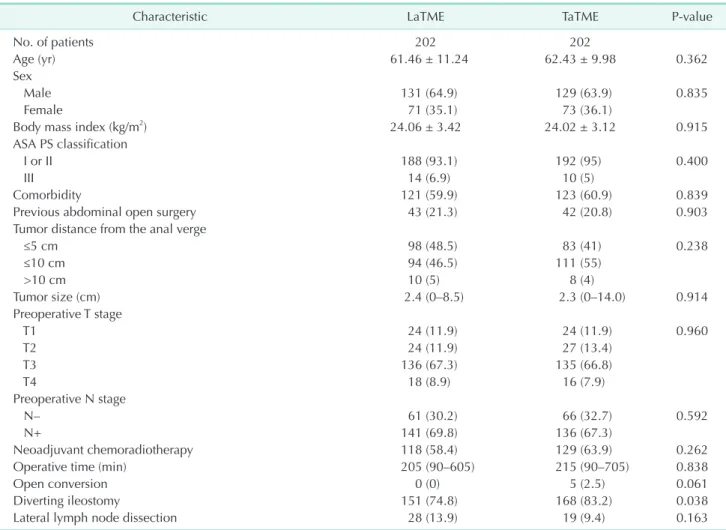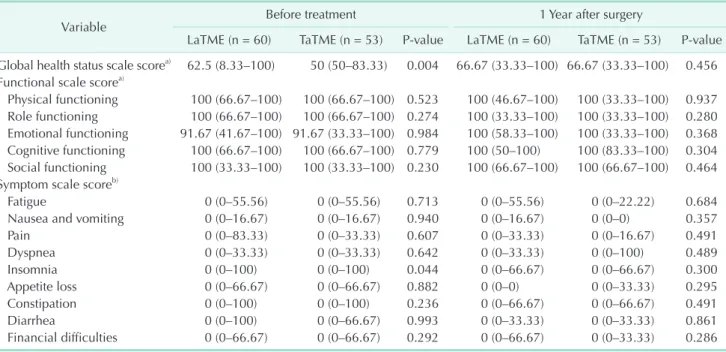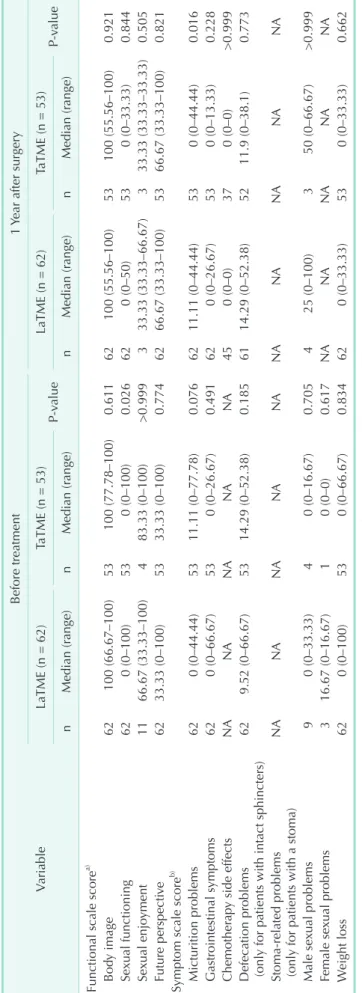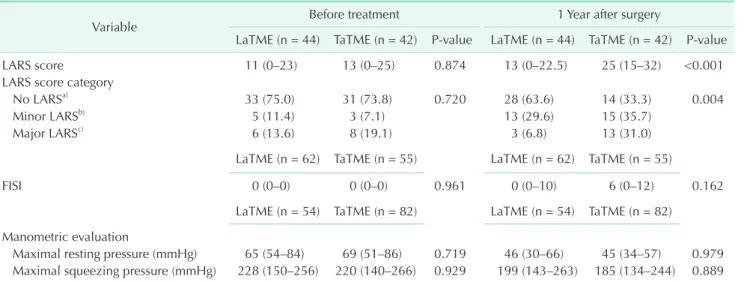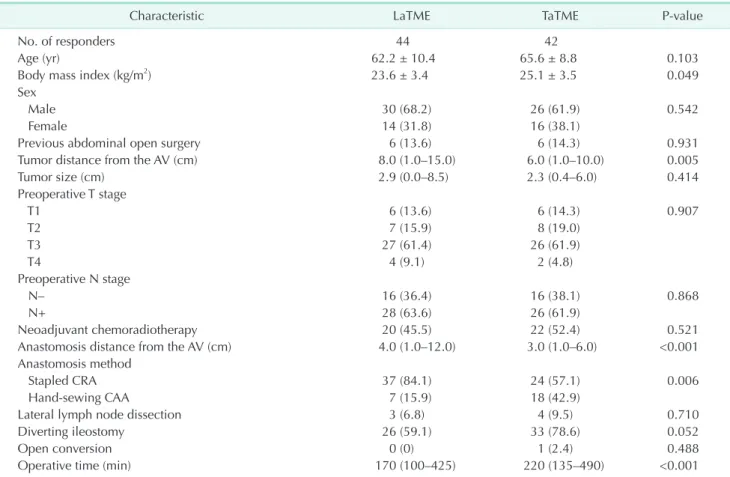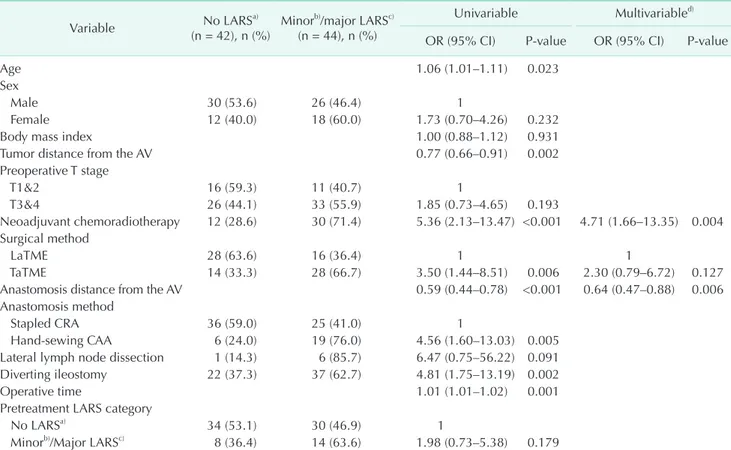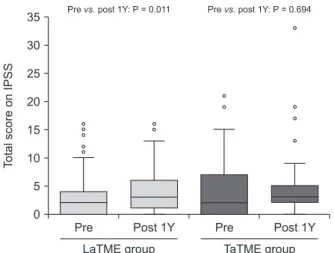https://doi.org/10.4174/astr.2021.101.1.1 Annals of Surgical Treatment and Research
Comparison of patient-reported quality of life and functional outcomes following laparoscopic and transanal total mesorectal excision of rectal cancer
Ryun Kyong Ha1,*, Sung Chan Park1,*, Boram Park2, Sung Sil Park1, Dae Kyung Sohn1, Hee Jin Chang1, Jae Hwan Oh1
1Center for Colorectal Cancer, Research Institute and Hospital, National Cancer Center, Goyang, Korea
2Biostatistics Collaboration Team, Research Institute, National Cancer Center, Goyang, Korea
INTRODUCTION
For colorectal cancer, several randomized controlled trials have suggested similar oncological outcomes between open and laparoscopic (La) total mesorectal excision (TME) [1-3]. In laparoscopic surgery for low rectal cancer, however, several
factors, including obesity, advanced T stage, and narrow pelvis, result in longer operative times and increase the risk of anastomotic leakage [4], which in turn potentially increase the risks of incomplete tumor resection and local recurrence [5].
Transanal TME (TaTME) was proposed to overcome technical limitations. The oncological safety and effectiveness of TaTME
Received February 16, 2021, Revised March 24, 2021, Accepted April 9, 2021
Corresponding Author: Jae Hwan Oh
Center for Colorectal Cancer, Research Institute and Hospital, National Cancer Center, 323 Ilsan-ro, Ilsandong-gu, Goyang 10108, Korea
Tel: +82-31-920-1505, Fax: +82-31-920-1511 E-mail: jayoh@ncc.re.kr
ORCID: https://orcid.org/0000-0002-5883-5815
*Ryun Kyong Ha and Sung Chan Park contributed equally to this study as co-first authors.
Copyright ⓒ 2021, the Korean Surgical Society
cc Annals of Surgical Treatment and Research is an Open Access Journal. All articles are distributed under the terms of the Creative Commons Attribution Non- Commercial License (http://creativecommons.org/licenses/by-nc/4.0/) which permits unrestricted non-commercial use, distribution, and reproduction in any medium, provided the original work is properly cited.
Purpose: The effect of transanal total mesorectal excision (TaTME) on patients’ quality of life and functional outcomes is not fully understood. This study aimed to compare the quality of life and bowel, anorectal, and urogenital functions after laparoscopic and TaTME.
Methods: Laparoscopic or TaTME was performed for 202 propensity score-matched patient pairs with rectal cancer between January 2014 and December 2017 at the National Cancer Center, Korea. The outcomes for all patients were assessed using anorectal manometry, the European Organization for Research and Treatment of Cancer (EORTC) Core Quality of Life Questionnaire (QLQ-C30) and Colorectal Cancer-Specific Quality of Life Questionnaire (QLQ-CR38), low anterior resection syndrome (LARS) score, Fecal Incontinence Severity Index, and International Prostate Symptom Score (IPSS). This retrospective comparative study included patients who completed anorectal manometry and the questionnaires before treatment and at 1 year after surgery.
Results: The EORTC QLQ-C30 and QLQ-CR38 showed comparable outcomes regarding the quality of life in both groups.
More patients experienced major LARS in the transanal group at 1 year postoperatively (31.0% vs. 6.8% in the laparoscopic group, P = 0.004). Multivariable analysis revealed no significant difference in the LARS score between the groups at 1 year postoperatively (odds ratio, 2.30; 95% confidence interval, 0.79–6.72; P = 0.127). Significant differences in the IPSS were not noted between the groups.
Conclusion: The quality of life and functional outcomes were comparable between the laparoscopic and transanal approaches; however, our findings suggest a higher rate of LARS after TaTME.
[Ann Surg Treat Res 2021;101(1):1-12]
Key Words: Fecal incontinence, Quality of life, Rectal neoplasms, Transanal endoscopic surgery
have been described by the International TaTME registry [6]. For postoperative functions, a more precise dissection may be achieved with the transanal approach than with the laparoscopic approach; thus, leading to improvements in the urogenital function and continence [7]. Several studies have evaluated the quality of life (QoL) or functional outcomes following TaTME, with some of them comparing these parameters with those following LaTME. However, most were retrospective studies, and the administration times of the questionnaires were not consistent and the populations were small. In addition, most dealt with some functions and excluded various affected outcomes. In this study, we hypothesized that TaTME would be an alternative to the laparoscopic approach in technically difficult cases. Thus, we previously reviewed the oncological outcomes after LaTME and TaTME [8], and this study focused on comparing the postoperative QoL and functional outcomes, including bowel, anorectal, and urogenital functions, between LaTME and TaTME.
METHODS
Study population
In our early experience, we published prospective, single- arm studies, in which TaTME was performed for rectal cancer located 3–12 cm from the anal verge (AV), excluding cases with a body mass index greater than 30 kg/m2, circumferential resection margin measured less than 1 mm on rectal magnetic resonance imaging, or clinical T4 stage [9,10]. However, recently, we assessed the feasibility of TaTME in challenging cases including obese patients, bulky tumors, or threatened mesorectal fascias in a prospective, single-arm setting [11].
Excluding cases with abdominoperineal resection, recurrent cancers, stage IV, or other malignancies, the oncological outcomes after LaTME and TaTME among patients with pathologically confirmed rectal adenocarcinoma treated between January 2014 and December 2017 at the National Cancer Center, Korea were reviewed retrospectively in the propensity score-matched population [8]. Different variables, including age, tumor distance from the AV, primary tumor size, neoadjuvant chemoradiotherapy, and lateral lymph node dissection, were matched during propensity score-matching analysis, and evaluation of the total cohort revealed that both groups were similar. For the same population, we performed this study involving comparisons of postoperative QoL and functional outcomes between LaTME and TaTME. This study was approved by the Institutional Review Board of National Cancer Center, Korea (No. NCC2019-0247). Informed consent was obtained from all the participants.
Preoperative evaluations, neoadjuvant therapy, and operative techniques for both LaTME and TaTME have previously been reported in detail [11]. TME was performed 4–8 weeks after
completion of neoadjuvant chemoradiotherapy. A diverting ileostomy was created in case of lower anastomosis or neoadjuvant chemoradiotherapy. Stoma reversal was performed at 3 months postoperatively or 1 month after adjuvant therapy, if indicated, after evaluating the anastomosis with loopogram and sigmoidoscopy.
The outcomes were assessed with validated questionnaires and anorectal manometry at the following 2 time points; before treatment (i.e., neoadjuvant chemoradiotherapy, if indicated, or TME) and at 1 year after TME. The questionnaires were administered by a single study coordinator, and she recorded the answers directly.
Only data of patients who completed the questionnaire at the 2 time points of evaluation were analyzed. Moreover, only the results of patients who had an anorectal manometry at the 2 time points of evaluation were analyzed. Patients without stoma reversal were excluded from the analysis of bowel and anorectal function.
Questionnaires
The outcomes for all patients were assessed using the European Organization for Research and Treatment of Cancer (EORTC) Core Quality of Life (QLQ-C30), Colorectal Cancer- Specific Quality of Life (QLQ-CR38), low anterior resection syndrome (LARS) score, Fecal Incontinence Severity Index (FISI), and International Prostate Symptom Score (IPSS) questionnaires.
The EORTC QLQ-C30 was used for measuring the QoL of cancer patients and comprised 5 functional scales (including social functioning), 3 symptom scales (including nausea and vomiting), 6 single items (including appetite loss), and a global health status scale [12].
The EORTC QLQ-CR38 was used for measuring the QoL of colorectal cancer patients and comprised 4 functional scales (including body image) and 8 symptom scales (including micturition problems and weight loss) [13]. In both the EORTC QLQ-C30 and QLQ-CR38, higher scores on the functional scales and global health status scale represent better health-related QoL. Higher scores on symptom scales/single items represent worse health-related QoL. A difference of ≥10 points was considered clinically significant [3].
The LARS score was used to evaluate the bowel and anorectal function after rectal cancer surgery. It comprises 5 items, including flatus incontinence, liquid stool incontinence, bowel frequency, clustering of stools, and urgency. On the basis of the total score, LARS is categorized as no (0–20), minor (21–29), or major (30–42) LARS [14].
The FISI was used for measuring the severity of fecal incontinence and associated factors. Each item with its different frequencies was assigned a weighted score. The total score ranged from 0 to 61. A higher score was indicative of more
severe fecal incontinence [15,16].
The IPSS was used for evaluating the factors describing the urinary function. It comprises 7 items, including incomplete emptying, frequency, intermittency, urgency, weak stream, straining, and nocturia. On the basis of the total score, the dysfunction was categorized as mild (0–7), moderate (8–19), or severe (20–35). The IPSS was also used to measure the QoL related to urinary symptoms, and the scores ranged from 0 (delighted) to 6 (terrible) [17].
Anorectal manometry
Anorectal manometry was performed to assess the anal sphincter functions. Bowel preparation was not routinely required. Patients were positioned in the left lateral decubitus position with the hips flexed at 90°. After perianal inspection and digital rectal examination, patients were evaluated using an eight-channel, water-perfused manometry system, and a standard catheter (Medical Measurement Systems, Enschede,
the Netherlands) by trained technical personnel.
We evaluated 2 parameters to assess internal and external anal sphincter functions (resting pressure and squeezing pressure of voluntary contraction), and the highest value recorded was considered valid.
Statistical analysis
To compare the characteristics between the 2 groups, the t-test or Wilcoxon rank-sum test was used to analyze the continuous variables, and Pearson chi-square test or Fisher exact test was used to analyze the categorical variables. The scores for each questionnaire were summarized as the median with range or interquartile range (Q1–Q3) for the continuous variables and the frequency with proportion for the categorical variables. Differences between the 2 groups were tested using Pearson chi-square test, Fisher exact test, or Wilcoxon rank-sum test. Wilcoxon signed-rank test was used to evaluate significant changes in continuous scores over the study period in each
Table 1. Baseline characteristics of the patients
Characteristic LaTME TaTME P-value
No. of patients 202 202
Age (yr) 61.46 ± 11.24 62.43 ± 9.98 0.362
Sex
Male 131 (64.9) 129 (63.9) 0.835
Female 71 (35.1) 73 (36.1)
Body mass index (kg/m2) 24.06 ± 3.42 24.02 ± 3.12 0.915
ASA PS classification
I or II 188 (93.1) 192 (95) 0.400
III 14 (6.9) 10 (5)
Comorbidity 121 (59.9) 123 (60.9) 0.839
Previous abdominal open surgery 43 (21.3) 42 (20.8) 0.903
Tumor distance from the anal verge
≤5 cm 98 (48.5) 83 (41) 0.238
≤10 cm 94 (46.5) 111 (55)
>10 cm 10 (5) 8 (4)
Tumor size (cm) 2.4 (0–8.5) 2.3 (0–14.0) 0.914
Preoperative T stage
T1 24 (11.9) 24 (11.9) 0.960
T2 24 (11.9) 27 (13.4)
T3 136 (67.3) 135 (66.8)
T4 18 (8.9) 16 (7.9)
Preoperative N stage
N– 61 (30.2) 66 (32.7) 0.592
N+ 141 (69.8) 136 (67.3)
Neoadjuvant chemoradiotherapy 118 (58.4) 129 (63.9) 0.262
Operative time (min) 205 (90–605) 215 (90–705) 0.838
Open conversion 0 (0) 5 (2.5) 0.061
Diverting ileostomy 151 (74.8) 168 (83.2) 0.038
Lateral lymph node dissection 28 (13.9) 19 (9.4) 0.163
Values are presented as number only, mean ± standard deviation, number (%), or median (range).
ASA, American Society of Anesthesiologists; PS, physical status; LaTME, laparoscopic total mesorectal excision; TaTME, transanal total mesorectal excision.
group. The LARS score was assessed using univariable and multivariable logistic regression models with the binary 1-year LARS score as a dependent variable (no vs. minor/major LARS).
All results were considered statistically significant when the 2-sided P-value was <0.05. Statistical analyses were performed with SAS software ver. 9.4 (SAS Institute, Cary, NC, USA) and R software ver. 3.6.2 (R Foundation for Statistical Computing, Vienna, Austria).
RESULTS
During the study period, 514 patients underwent LaTME, and 208 underwent TaTME. After matching, 202 patient pairs were included. Both groups showed similar baseline characteristics except for a diverting ileostomy (74.8% in the laparoscopic group vs. 83.2% in the transanal group, P = 0.038) (Table 1).
Stoma reversal was not performed in 15 patients; 7 in the LaTME group and 8 in the TaTME group.
Quality of life based on the EORTC QLQ-C30 and QLQ-CR38
A total of 113 patients completed the EORTC QLQ-C30 at both time points of evaluation; 60 patients in the LaTME group and 53 patients in the TaTME group. Before treatment, the global health status scale score was significantly worse in the TaTME group than in the LaTME group (P = 0.004), but it was comparable between the groups at 1 year after TME (Table 2).
Thus, we did a pairwise comparison of the scale at different times in each group. In the LaTME group, the scale showed no significant changes at 1 year postoperatively. However, in the TaTME group, the scale at 1 year postoperatively showed improvement relative to that before treatment (P = 0.024).
Otherwise, both groups were comparable (Table 2).
A total of 115 patients (62 patients in the LaTME group and 53 patients in the TaTME group) answered the EORTC QLQ-CR38 at both time points of evaluation. The scales for chemotherapy side effects and stoma-related problems were omitted before treatment. The scale for chemotherapy side effects was calculated for patients who had received neoadjuvant chemoradiotherapy or adjuvant chemotherapy, and the result was comparable between the groups. For 1 patient, a stoma reversal was not performed and questions for stoma- related problems 1 year postoperatively were not answered.
The questions about sexual enjoyment, male sexual problems, and female sexual problems, which were applicable to sexually active patients, were completed by 6, 7, and zero patients, respectively, at 1 year. At 1 year, the score for micturition problems was worse in the LaTME group than in the TaTME group (P = 0.016). Both groups showed comparable results for the remaining scales (Table 3).
Bowel and anorectal functions based on the LARS score, FISI, and anorectal manometry
Table 4 shows a comparison of the LARS score, FISI, and the
Table 2. Results of the European Organization for Research and Treatment of Cancer Core Quality of Life Questionnaire
Variable Before treatment 1 Year after surgery
LaTME (n = 60) TaTME (n = 53) P-value LaTME (n = 60) TaTME (n = 53) P-value Global health status scale scorea) 62.5 (8.33–100) 50 (50–83.33) 0.004 66.67 (33.33–100) 66.67 (33.33–100) 0.456 Functional scale scorea)
Physical functioning 100 (66.67–100) 100 (66.67–100) 0.523 100 (46.67–100) 100 (33.33–100) 0.937 Role functioning 100 (66.67–100) 100 (66.67–100) 0.274 100 (33.33–100) 100 (33.33–100) 0.280 Emotional functioning 91.67 (41.67–100) 91.67 (33.33–100) 0.984 100 (58.33–100) 100 (33.33–100) 0.368 Cognitive functioning 100 (66.67–100) 100 (66.67–100) 0.779 100 (50–100) 100 (83.33–100) 0.304 Social functioning 100 (33.33–100) 100 (33.33–100) 0.230 100 (66.67–100) 100 (66.67–100) 0.464 Symptom scale scoreb)
Fatigue 0 (0–55.56) 0 (0–55.56) 0.713 0 (0–55.56) 0 (0–22.22) 0.684
Nausea and vomiting 0 (0–16.67) 0 (0–16.67) 0.940 0 (0–16.67) 0 (0–0) 0.357
Pain 0 (0–83.33) 0 (0–33.33) 0.607 0 (0–33.33) 0 (0–16.67) 0.491
Dyspnea 0 (0–33.33) 0 (0–33.33) 0.642 0 (0–33.33) 0 (0–100) 0.489
Insomnia 0 (0–100) 0 (0–100) 0.044 0 (0–66.67) 0 (0–66.67) 0.300
Appetite loss 0 (0–66.67) 0 (0–66.67) 0.882 0 (0–0) 0 (0–33.33) 0.295
Constipation 0 (0–100) 0 (0–100) 0.236 0 (0–66.67) 0 (0–66.67) 0.491
Diarrhea 0 (0–100) 0 (0–66.67) 0.993 0 (0–33.33) 0 (0–33.33) 0.861
Financial difficulties 0 (0–66.67) 0 (0–66.67) 0.292 0 (0–66.67) 0 (0–33.33) 0.286 Values are presented as median (range); the scale ranges from 0 to 100.
LaTME, laparoscopic total mesorectal excision; TaTME, transanal total mesorectal excision.
a)A higher score represents better health-related quality of life. b)A higher score represents worse health-related quality of life.
Table 3. Results of the European Organization for Research and Treatment of Cancer Colorectal Cancer-Specific Quality of Life Questionnaire Variable
Before treatment1 Year after surgery LaTME (n = 62)TaTME (n = 53) P-valueLaTME (n = 62)TaTME (n = 53) P-value nMedian (range)nMedian (range)nMedian (range)nMedian (range) Functional scale scorea) Body image62100 (66.67–100)53100 (77.78–100)0.61162100 (55.56–100)53100 (55.56–100)0.921 Sexual functioning620 (0–100)530 (0–100)0.026620 (0–50)530 (0–33.33)0.844 Sexual enjoyment1166.67 (33.33–100) 483.33 (0–100)>0.999 333.33 (33.33–66.67) 333.33 (33.33–33.33)0.505 Future perspective6233.33 (0–100)5333.33 (0–100)0.7746266.67 (33.33–100)5366.67 (33.33–100)0.821 Symptom scale scoreb) Micturition problems620 (0–44.44)5311.11 (0–77.78)0.0766211.11 (0–44.44)530 (0–44.44)0.016 Gastrointestinal symptoms620 (0–66.67)530 (0–26.67)0.491620 (0–26.67)530 (0–13.33)0.228 Chemotherapy side effectsNANANANANA450 (0–0)370 (0–0)>0.999 Defecation problems (only for patients with intact sphincters)629.52 (0–66.67)5314.29 (0–52.38)0.1856114.29 (0–52.38)5211.9 (0–38.1)0.773 Stoma-related problems (only for patients with a stoma)NANANANANANANANANANA Male sexual problems 90 (0–33.33) 40 (0–16.67)0.705 425 (0–100) 350 (0–66.67)>0.999 Female sexual problems 316.67 (0–16.67) 10 (0–0)0.617NANANANANA Weight loss620 (0–100)530 (0–66.67)0.834620 (0–33.33)530 (0–33.33)0.662 Values are presented as the number of responders for each scale and median (range) of the score; the scale ranges from 0 to 100. LaTME, laparoscopic total mesorectal excision; TaTME, transanal total mesorectal excision; NA, not available. a) A higher score represents better health-related quality of life. b) A higher score represents worse health-related quality of life.
Table 4. Results of the LARS score, FISI, and manometric evaluations
Variable Before treatment 1 Year after surgery
LaTME (n = 44) TaTME (n = 42) P-value LaTME (n = 44) TaTME (n = 42) P-value
LARS score 11 (0–23) 13 (0–25) 0.874 13 (0–22.5) 25 (15–32) <0.001
LARS score category
No LARSa) 33 (75.0) 31 (73.8) 0.720 28 (63.6) 14 (33.3) 0.004
Minor LARSb) 5 (11.4) 3 (7.1) 13 (29.6) 15 (35.7)
Major LARSc) 6 (13.6) 8 (19.1) 3 (6.8) 13 (31.0)
LaTME (n = 62) TaTME (n = 55) LaTME (n = 62) TaTME (n = 55)
FISI 0 (0–0) 0 (0–0) 0.961 0 (0–10) 6 (0–12) 0.162
LaTME (n = 54) TaTME (n = 82) LaTME (n = 54) TaTME (n = 82) Manometric evaluation
Maximal resting pressure (mmHg) 65 (54–84) 69 (51–86) 0.719 46 (30–66) 45 (34–57) 0.979 Maximal squeezing pressure (mmHg) 228 (150–256) 220 (140–266) 0.929 199 (143–263) 185 (134–244) 0.889 Values are presented as median (interquartile range) or number (%).
LARS, low anterior resection syndrome; FISI, Fecal Incontinence Severity Index; LaTME, laparoscopic total mesorectal excision;
TaTME, transanal total mesorectal excision.
a)0–20, b)21–29, and c)30–42.
Pre
LARSscore
LaTME group 42
36 30 24 18 12 6 0
Post 1Y Pre Post 1Y TaTME group Prevs.post 1Y: P = 0.939 Prevs.post 1 : P < 0.001Y
Pre
FISI
LaTME group 61
50
40
30
20
10
0
Post 1Y Pre Post 1Y TaTME group Prevs.post 1 : P = 0.003Y Prevs.post 1 : P < 0.001Y
Pre
Maximalrestingpressure(mmHg)
LaTME group 140
120 100 80 60 40 20
-20
Post 1Y Pre Post 1Y TaTME group Prevs.post 1 : P < 0.001Y Prevs.post1Y: P < 0.001
Pre
Maximalsqueezingpressure(mmHg)
LaTME group 550
500 450 400 350 300 250 200 150 100 50 0
Post 1Y Pre Post 1Y TaTME group Prevs.post 1 : P = 0.002Y Prevs.post 1 : P < 0.001Y
0
A B
C D
Fig. 1. Scores measured before treatment (Pre) and at 1 year postoperatively (Post 1Y). (A) Lower anterior resection syndrome (LARS) score, (B) Fecal Incontinence Severity Index (FISI), (C) maximal resting pressure on anorectal manometry, and (D) maximal squeezing pressure on anorectal manometry. LaTME, laparoscopic total mesorectal excision; TaTME, transanal total mesorectal excision.
results of anorectal manometry between the groups. Fig. 1 shows the change in each index before and after treatment in both groups.
LARS score
Eighty-seven patients completed the LARS questionnaire at both time points of evaluation. Excluding 1 patient for whom stoma reversal was not noted, 86 patients were included in the analysis; 44 patients in the LaTME group and 42 patients in the TaTME group. At 1 year postoperatively, the LARS score was significantly higher in the TaTME group than in the LaTME group (P < 0.001). A greater number of patients were classified as having major LARS at 1 year (P = 0.004) after TaTME than after LaTME. In the LaTME group, the scores did not significantly differ between before treatment and at 1 year postoperatively. However, in the TaTME group, the score at 1 year was significantly higher than that before treatment (P <
0.001).
When comparing the baseline characteristics of the LARS questionnaire responders (Table 5), the TaTME group showed a significantly shorter tumor distance from the AV (P = 0.005),
shorter anastomosis distance from the AV (P < 0.001), higher frequency of hand-sewn coloanal anastomosis (P = 0.006), and longer operative time (P < 0.001) than did the LaTME group. Thus, we examined the difference in 1-year LARS (no vs. minor/major) between the LaTME and TaTME groups in a multivariable model that was adjusted for 2 clinical factors, neoadjuvant chemoradiotherapy and anastomosis distance from the AV, which statistically affect 1-year LARS (no vs.
minor/major) (Table 6). The results showed that there was no statistically significant difference between the groups (odds ratio, 2.30; 95% confidence interval, 0.79–6.72; P = 0.127).
FISI
A total of 118 patients completed the FISI questionnaire at both time points of evaluation. Excluding a patient for whom stoma reversal was not noted, 117 patients were included in the analysis; 62 patients in the LaTME group and 55 patients in the TaTME group. Significant differences were not observed between the groups. In both groups, the FISI at 1 year was significantly increased (P = 0.003 in the LaTME group and P <
0.001 in the TaTME group) relative to the score before treatment.
Table 5. Baseline characteristics of the LARS questionnaire responders
Characteristic LaTME TaTME P-value
No. of responders 44 42
Age (yr) 62.2 ± 10.4 65.6 ± 8.8 0.103
Body mass index (kg/m2) 23.6 ± 3.4 25.1 ± 3.5 0.049
Sex
Male 30 (68.2) 26 (61.9) 0.542
Female 14 (31.8) 16 (38.1)
Previous abdominal open surgery 6 (13.6) 6 (14.3) 0.931
Tumor distance from the AV (cm) 8.0 (1.0–15.0) 6.0 (1.0–10.0) 0.005
Tumor size (cm) 2.9 (0.0–8.5) 2.3 (0.4–6.0) 0.414
Preoperative T stage
T1 6 (13.6) 6 (14.3) 0.907
T2 7 (15.9) 8 (19.0)
T3 27 (61.4) 26 (61.9)
T4 4 (9.1) 2 (4.8)
Preoperative N stage
N– 16 (36.4) 16 (38.1) 0.868
N+ 28 (63.6) 26 (61.9)
Neoadjuvant chemoradiotherapy 20 (45.5) 22 (52.4) 0.521
Anastomosis distance from the AV (cm) 4.0 (1.0–12.0) 3.0 (1.0–6.0) <0.001
Anastomosis method
Stapled CRA 37 (84.1) 24 (57.1) 0.006
Hand-sewing CAA 7 (15.9) 18 (42.9)
Lateral lymph node dissection 3 (6.8) 4 (9.5) 0.710
Diverting ileostomy 26 (59.1) 33 (78.6) 0.052
Open conversion 0 (0) 1 (2.4) 0.488
Operative time (min) 170 (100–425) 220 (135–490) <0.001
Values are presented as number only, mean ± standard deviation, number (%), or median (range).
LARS, lower anterior resection syndrome; LaTME, laparoscopic total mesorectal excision; TaTME, transanal total mesorectal excision;
AV, anal verge; CRA, colorectal anastomosis; CAA, coloanal anastomosis.
Anorectal manometry
A total of 136 patients underwent anorectal manometry at both time points of evaluation; 54 patients in the LaTME group and 82 patients in the TaTME group. Stoma reversal was successful in all patients. While no significant differences were observed between the groups, both the maximal resting pressure (P < 0.001 in the LaTME group and P < 0.001 in the
TaTME group) and maximal squeezing pressure (P = 0.002 in the LaTME group and P < 0.001 in the TaTME group) at 1 year were significantly decreased relative to the values noted before treatment.
Urinary function based on IPSS
A total of 115 patients, 62 patients in the LaTME group and 53 Table 6. Results of the univariable and multivariable logistic regression analyses for the LARS score at 1 year postoperatively
Variable No LARSa)
(n = 42), n (%) Minorb)/major LARSc) (n = 44), n (%)
Univariable Multivariabled) OR (95% CI) P-value OR (95% CI) P-value
Age 1.06 (1.01–1.11) 0.023
Sex
Male 30 (53.6) 26 (46.4) 1
Female 12 (40.0) 18 (60.0) 1.73 (0.70–4.26) 0.232
Body mass index 1.00 (0.88–1.12) 0.931
Tumor distance from the AV 0.77 (0.66–0.91) 0.002
Preoperative T stage
T1&2 16 (59.3) 11 (40.7) 1
T3&4 26 (44.1) 33 (55.9) 1.85 (0.73–4.65) 0.193
Neoadjuvant chemoradiotherapy 12 (28.6) 30 (71.4) 5.36 (2.13–13.47) <0.001 4.71 (1.66–13.35) 0.004 Surgical method
LaTME 28 (63.6) 16 (36.4) 1 1
TaTME 14 (33.3) 28 (66.7) 3.50 (1.44–8.51) 0.006 2.30 (0.79–6.72) 0.127
Anastomosis distance from the AV 0.59 (0.44–0.78) <0.001 0.64 (0.47–0.88) 0.006
Anastomosis method
Stapled CRA 36 (59.0) 25 (41.0) 1
Hand-sewing CAA 6 (24.0) 19 (76.0) 4.56 (1.60–13.03) 0.005
Lateral lymph node dissection 1 (14.3) 6 (85.7) 6.47 (0.75–56.22) 0.091
Diverting ileostomy 22 (37.3) 37 (62.7) 4.81 (1.75–13.19) 0.002
Operative time 1.01 (1.01–1.02) 0.001
Pretreatment LARS category
No LARSa) 34 (53.1) 30 (46.9) 1
Minorb)/Major LARSc) 8 (36.4) 14 (63.6) 1.98 (0.73–5.38) 0.179
LARS, low anterior resection syndrome; OR, odds ratio; CI, confidence interval; AV, anal verge; LaTME, laparoscopic total mesorectal excision; TaTME, transanal total mesorectal excision; CRA, colorectal anastomosis; CAA, coloanal anastomosis.
a)0–20, b)21–29, and c)30–42. d)We performed multivariable analysis by adjusting for the clinically and statistically significant factors in the univariable analyses.
Table 7. Results of the IPSS
Variable Before treatment 1 Year after surgery
LaTME (n = 62) TaTME (n = 53) P-value LaTME (n = 62) TaTME (n = 53) P-value
IPSS 2 (0–4) 2 (0–7) 0.324 3 (1–6) 3 (2–5) 0.723
IPSS categories
Mild dysfunctiona) 54 (87.1) 40 (75.5) 0.144 51 (82.3) 45 (84.9) 0.523
Moderate dysfunctionb) 8 (12.9) 11 (20.7) 11 (17.7) 7 (13.2)
Severe dysfunctionc) 0 (0) 2 (3.8) 0 (0) 1 (1.9)
Urinary symptom-related QoL scale 0 (0–1) 0 (0–1) 0.457 0 (0–1) 0 (0–1) 0.892
Values are presented as median (interquartile range) or number (%).
IPSS, International Prostate Symptom Score; LaTME, laparoscopic total mesorectal excision; TaTME, transanal total mesorectal excision; QoL, quality of life.
a)0–7, b)8–19, c)20–35.
patients in the TaTME group, completed the IPSS questionnaire at both time points of evaluation. Significant differences between the groups were not observed with respect to the total score, severity score, and QoL score related to urinary symptoms (Table 7). In the LaTME group, the IPSS at 1 year was significantly increased (P = 0.011) relative to the scores noted before treatment. However, in the TaTME group, significant changes in the IPSS were not observed at 1 year postoperatively (Fig. 2).
DISCUSSION
This study evaluated and compared QoL and functional outcomes following LaTME and TaTME in rectal cancer patients. The health-related QoL scores and IPSS were similar between the groups. Although the FISI and anorectal manometry results were comparable between the groups, the postoperative LARS score was worse in the TaTME group than in the LaTME group. However, multivariable analysis showed no statistically significant difference in the LARS score between the groups at 1 year postoperatively (P = 0.127).
For low rectal cancer, sphincter-preserving surgery with intersphincteric resection may prevent a permanent stoma, but lower anastomosis consequently results in LARS in the long term [18] and affects QoL [19]. Previous studies reported comparable LARS scores between patients who underwent LaTME and those who underwent TaTME [20,21]; however, the sample populations in these studies were small. In this study, a greater number of patients were classified as having major LARS at 1 year postoperatively after TaTME than after LaTME.
Endoanal instrumentation during the transanal approach may have caused anal sphincter damage and aggravated LARS [22];
this notion was supported by Keller et al. [23] who reported
that longer perineal operation time was associated with worsening of LARS. However, owing to the significantly lower anastomosis level among the LARS questionnaire responders in the TaTME group, we performed a multivariable analysis and found that TaTME was not a significant risk factor for LARS. In addition, the EORTC QoL scale score related to gastrointestinal symptoms, FISI, and results of manometric evaluations were comparable between the groups.
In this study, as in previous studies, neoadjuvant chemoradiotherapy and lower anastomosis were identified as significant predictors of LARS. Among patients who underwent curative low anterior resection for nondisseminated rectal cancer, neoadjuvant therapy, short- or long-course (chemo) radiotherapy, and TME were strongly associated with major LARS [24]. The FOWARC (Neoadjuvant FOLFOX6 Chemotherapy With or Without Radiation in Rectal Cancer) trial suggested that long-course neoadjuvant radiation therapy and lower anastomosis were the independent risk factors for major LARS [25].
Previous studies that used the EORTC QLQ-C30 showed comparable outcomes of QoL between the groups [21,26].
However, in this study, the score of global health status scale before treatment was worse in the TaTME group than in the LaTME group. However, the analysis for each questionnaire was based on the number of subjects who responded to that questionnaire; therefore, differences in baseline characteristics may exist between the groups. In addition, we did a pairwise comparison of each group for the score of global health status scale, and the result showed that the TaTME group improved after surgery, while the LaTME group showed no significant changes over the study period. This result may suggest a more severe cancer status in the TaTME group than in the LaTME group. In addition, the global health status score was comparable between the groups at 1 year postoperatively, and the results for the remaining scales were comparable between the groups.
With respect to the EORTC QLQ-CR38 or QLQ-CR29 (updated version), previous studies reported that symptoms, including fecal incontinence, were worse in the TaTME group than in the LaTME group [21,26]. In this study, the results for the related scales were comparable between the groups. In addition, both groups were not significantly different with respect to the LARS score and FISI, which are more specifically developed to assess bowel and anorectal functions than is EORTC QLQ-CR38 or QLQ-CR29.
The IPSS was comparable between the groups; this finding was in agreement with those reported in previous studies [20,21]. However, Bjoern et al. [26] reported that the QoL related to urinary symptoms was better for patients who underwent TaTME than for those who underwent LaTME. In this study, pretreatment IPSS was comparable between the
Pre
TotalscoreonIPSS
LaTME group 35
30 25 20 15 10 5 0
Post 1Y Pre Post 1Y TaTME group Prevs.post 1Y: P = 0.011 Prevs.post 1Y: P = 0.694
Fig. 2. Total International Prostate Symptom Score (IPSS) measured before treatment (Pre) and at 1 year postoperatively (Post 1Y). LaTME, laparoscopic total mesorectal excision;
TaTME, transanal total mesorectal excision.
groups, assuming that there were no significant differences in the incidence of symptomatic benign prostatic hyperplasia or degree of cancer progression between the groups. However, IPSS significantly worsened at 1 year postoperatively in the LaTME group but was comparable before and after treatment in the TaTME group. In addition, the EORTC QoL scale for micturition problems at 1 year was worse in the LaTME group than in the TaTME group. During LaTME, pelvic dissection and traction of the bladder near the Denonvilliers’ fascia may result in damage to the autonomic nerves [27]. Thus, TaTME may aid in the preservation of the autonomic nerves.
With respect to male sexual function, Pontallier et al.
[20] reported that patients in the TaTME group (71%) and LaTME group (39%) in their study maintained sexual activity postoperatively, and the laparoscopic approach was a predictive factor for the loss of sexual activity. They also reported better postoperative erectile and ejaculatory functions in the TaTME group than in the LaTME group, although the difference was not statistically significant. With respect to female sexual function, previous studies reported low completion rates of the questionnaires and low rate of sexual activity as limitations [23,28]. In this study, the sexual function of 260 male patients was assessed with the International Index of Erectile Function questionnaire, which was applicable to sexually active patients;
104 patients completed the questionnaire before treatment, and 25 reported sexual activity (18 patients in the LaTME group and 7 patients in the TaTME group). Among the patients who were sexually active before treatment, 6 patients in the LaTME group and 2 patients in the TaTME group maintained sexual activity at 1 year postoperatively. We also assessed female sexual function using the Female Sexual Function Index questionnaire; however, only 2 women responded at 1 year after TME. In addition, the response rates for the EORTC QoL sexual scales were low. Owing to the small size of the sample population, valid statistical analysis for sexual function could not be performed. Thus, larger-scale studies are required to evaluate sexual function following TaTME.
Compared with previous studies, the present study holds strength in the fact that we attempted to evaluate QoL and the varied spectra of the affected functions following TaTME. In addition, previous relevant studies evaluated the questionnaires not at a designated time point, but for a certain period after TME. However, we evaluated the questionnaires at designated time points, before treatment and at 1 year after TME when patients visited the outpatient clinic. The consistency of the study design, such that only patients with available data for the 2 time points assessed were included, is another strength of the study. Furthermore, this study is the first to analyze the results of anorectal manometry with respect to the evaluation of the functional outcomes of TaTME. The procedure may be examiner-dependent, but it provides digitized information and
complements the subjectivity of the questionnaires. In contrast, the subjectivity of the questionnaires may lead to differences between the self-assessed functional outcomes and real functions.
In addition, only data of patients who completed the questionnaires or manometric evaluations at the 2 designated time points were analyzed in each evaluation. Therefore, differences in baseline characteristics may exist between the groups, and this is a major limitation of our study.
This was a retrospective study, and the response rate was low. Nevertheless, we tried to evaluate QoL and the varied spectra of the affected functions in 1 population. Thus, we used the previous propensity score-matched population and hypothesized that the 2 groups of each evaluation would be balanced in baseline characteristics. In addition, this was a single-institution study, which may not be representative of general outcomes. Another study limitation includes the preoperative LARS evaluation. The LARS score is not validated for use in a preoperative group, but we applied it before TME to compare it with that after TME.
In conclusion, LaTME and TaTME were comparable in terms of QoL and bowel, anorectal, and urinary functions. The rate of LARS was higher in the TaTME group at 1 year postoperatively;
however, large prospective studies with long-term follow-up are required to clarify whether the higher rate of LARS following TaTME is the result of selecting patients with tumors located close to the AV or whether it is attributable to the TaTME technique itself.
ACKNOWLEDGEMENTS
Fund/Grant Support
This project was supported by grants from the National Cancer Center, Korea (Grant number: 1810190 and 2110200) and a grant from the Research Core Center, Biostatistics Collaboration Team in the National Cancer Center Korea.
Conflicts of Interest
No potential conflict of interest relevant to this article was reported.
ORCID iD
Ryun Kyong Ha: https://orcid.org/0000-0003-1032-9611 Sung Chan Park: https://orcid.org/0000-0003-3949-7862 Boram Park: https://orcid.org/0000-0003-2683-8795 Sung Sil Park: https://orcid.org/0000-0002-8579-3526 Dae Kyung Sohn: https://orcid.org/0000-0003-3296-6646 Hee Jin Chang: https://orcid.org/0000-0003-2263-2247 Jae Hwan Oh: https://orcid.org/0000-0002-5883-5815
Author Contribution
Conceptualization: RKH, SCP, SSP, DKS, HJC, JHO Formal Analysis: RKH, SCP, BP, JHO
Investigation: RKH, SCP
Writing – Original Draft: RKH, SCP
Writing – Review & Editing: RKH, SCP, BP, SSP, DKS, HJC, JHO
REFERENCES
1. K ang SB, Park J W, Jeong SY, Nam BH, Choi HS, Kim DW, et al. Open versus laparoscopic surgery for mid or low rectal cancer after neoadjuvant chemoradiotherapy (COREAN trial):
short-term outcomes of an open- label randomised controlled trial. Lancet Oncol 2010;11:637-45.
2. van der Pas MH, Haglind E, Cuesta MA, Fürst A, Lacy AM, Hop WC, et al.
Laparoscopic versus open surgery for rectal cancer (COLOR II): short-term outcomes of a randomised, phase 3 trial.
Lancet Oncol 2013;14:210-8.
3. Jeong SY, Park JW, Nam BH, Kim S, Kang SB, Lim SB, et al. Open versus laparoscopic surgery for mid-rectal or low-rectal cancer after neoadjuvant chemoradiotherapy (COREAN trial): survival outcomes of an open-label, non-inferiority, randomised controlled trial. Lancet Oncol 2014;15:767- 74.
4. Akiyoshi T, Kuroyanagi H, Oya M, Konishi T, Fukuda M, Fujimoto Y, et al. Factors affecting the difficulty of laparoscopic total mesorectal excision with double stapling technique anastomosis for low rectal cancer. Surgery 2009;146:483-9.
5. Wibe A, Rendedal PR, Svensson E, Norstein J, Eide TJ, Myrvold HE, et al. Prognostic significance of the circumferential resection margin following total mesorectal excision for rectal cancer. Br J Surg 2002;89:327-34.
6. Penna M, Hompes R, Arnold S, Wynn G, Austin R, Warusavitarne J, et al. Transanal total mesorectal excision: international registry results of the first 720 cases. Ann Surg 2017;266:111-7.
7. Kneist W, Wachter N, Paschold M, Kauff DW, Rink AD, Lang H. Midterm functional results of taTME with neuromapping
for low rectal cancer. Tech Coloproctol 2016;20:41-9.
8. Alhanafy MK, Park SS, Park SC, Park B, Kim MJ, Sohn DK, et al. Early experience with transanal total mesorectal excision compared with laparoscopic total mesorectal excision for rectal cancer: a propensity score-matched analysis. Dis Colon Rectum 2020;63:1500-10.
9. Oh JH, Park SC, Kim MJ, Park BK, Hyun JH, Chang HJ, et al. Feasibility of transanal endoscopic total mesorectal excision for rectal cancer: results of a pilot study. Ann Surg Treat Res 2016;91:187-94.
10. Park SC, Sohn DK, Kim MJ, Chang HJ, Han KS, Hyun JH, et al. Phase II clinical trial to evaluate the efficacy of transanal endoscopic total mesorectal excision for rectal cancer. Dis Colon Rectum 2018;61:554-60.
11. Sohn DK, Park SC, Kim MJ, Chang HJ, Han KS, Oh JH. Feasibility of transanal total mesorectal excision in cases with challenging patient and tumor characteristics. Ann Surg Treat Res 2019;96:123-30.
12. Sprangers MA, Cull A, Groenvold M, Bjordal K, Blazeby J, Aaronson NK. The European Organization for Research and Treatment of Cancer approach to developing questionnaire modules: an update and overview. EORTC Quality of Life Study Group. Qual Life Res 1998;7:291-300.
13. Sprangers MA, te Velde A, Aaronson NK. The construction and testing of the EORTC colorectal cancer-specific quality of life questionnaire module (QLQ-CR38).
European Organization for Research and Treatment of Cancer Study Group on Quality of Life. Eur J Cancer 1999;35:238- 47.
14. Juul T, Ahlberg M, Biondo S, Emmertsen K J, E sp i n E , Ji me ne z L M, e t a l . International validation of the low anterior resection syndrome score. Ann Surg 2014;259:728-34.
15. Rockwood TH, Church JM, Fleshman JW, Kane RL, Mavrantonis C, Thorson AG, et al. Patient and surgeon ranking of the severity of symptoms associated with fecal incontinence: the fecal incontinence severity index. Dis Colon Rectum 1999;42:1525-32.
16. Rockwood TH. Incontinence severity and QOL scales for fecal incontinence.
Gastroenterology 2004;126(1 Suppl 1):S106-13.
17. Barry MJ, Fowler FJ Jr, O’Leary MP, Bruskewitz RC, Holtgrewe HL, Mebust WK, et al. The American Urological Association symptom index for benign prostatic hyperplasia. The Measurement Committee of the American Urological Association. J Urol 1992;148:1549-57.
18. Pieniowski EH, Palmer GJ, Juul T, Lagergren P, Johar A, Emmertsen KJ, et al. Low anterior resection syndrome and quality of life after sphincter- sparing rectal cancer surgery: a long-term longitudinal follow-up. Dis Colon Rectum 2019;62:14-20.
19. Emmertsen KJ, Laurberg S; Rectal Cancer Function Study Group. Impact of bowel dysfunction on quality of life after sphincter-preserving resection for rectal cancer. Br J Surg 2013;100:1377-87.
20. Pontallier A, Denost Q, Van Geluwe B, Adam JP, Celerier B, Rullier E. Potential sexual function improvement by using transanal mesorectal approach for laparoscopic low rectal cancer excision.
Surg Endosc 2016;30:4924-33.
21. Veltcamp Helbach M, Koedam TW, Knol
JJ, Velthuis S, Bonjer HJ, Tuynman JB, et al. Quality of life after rectal cancer surgery: differences between laparoscopic and transanal total mesorectal excision.
Surg Endosc 2019;33:79-87.
22. Bryant CL, Lunniss PJ, Knowles CH, Thaha MA, Chan CL. Anterior resection syndrome. Lancet Oncol 2012;13:e403-8.
23. Keller DS, Reali C, Spinelli A, Penna M, Di Candido F, Cunningham C, et al. Patient- reported functional and quality-of-life outcomes after transanal total mesorectal excision. Br J Surg 2019;106:364-6.
24. Bregendahl S, Emmertsen KJ, Lous J, Laurberg S. Bowel dysfunction after low
anterior resection with and without neoadjuvant therapy for rectal cancer: a population-based cross-sectional study.
Colorectal Dis 2013;15:1130-9.
25. Sun W, Dou R, Chen J, Lai S, Zhang C, Ruan L, et al. Impact of long-course neoadjuvant radiation on postoperative low anterior resection syndrome and quality of life in rectal cancer: post hoc analysis of a randomized controlled trial.
Ann Surg Oncol 2019;26:746-55.
26. Bjoern MX, Nielsen S, Perdawood SK.
Quality of life after surgery for rectal cancer: a comparison of functional outcomes after transanal and laparoscopic
approaches. J Gastrointest Surg 2019;23:
1623-30.
27. Liu J, Huang P, Liang Q, Yang X, Zheng Z, Wei H. Preservation of Denonvilliers’
fascia for nerve-sparing laparoscopic total mesorectal excision: a neuro-histological study. Clin Anat 2019;32:439-45.
28. Koedam TW, van Ramshorst GH, Deijen CL, Elfrink AK, Meijerink WJ, Bonjer HJ, et al. Transanal total mesorectal excision (TaTME) for rectal cancer: effects on patient-reported quality of life and functional outcome. Tech Coloproctol 2017;21:25-33.
